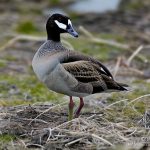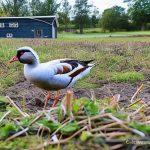Sebastopol Geese, also known as the “Curly Geese,” are a unique and beautiful breed of domestic geese that originated in Europe. They are believed to have been developed in the city of Sebastopol, in the Crimea region of Ukraine, hence their name. These geese were first introduced to North America in the mid-19th century and have since gained popularity for their distinctive appearance and gentle temperament.
One of the most striking features of Sebastopol Geese is their curly feathers. Unlike other geese breeds, Sebastopols have long, soft, and curly feathers that give them a fluffy and elegant appearance. These feathers can come in various colors, including white, gray, buff, and lavender. Sebastopols also have a slender body with a long neck and a small head. They are medium-sized geese, with males weighing around 12-14 pounds and females weighing around 10-12 pounds.
Key Takeaways
- Sebastopol Geese are a unique breed known for their curly feathers and calm temperament.
- Keeping Sebastopol Geese can provide benefits such as pest control, egg production, and meat.
- Housing for Sebastopol Geese should include a secure shelter and access to water for swimming.
- Feeding Sebastopol Geese a balanced diet and providing clean water is essential for their health.
- Regular veterinary care and attention to signs of illness can help maintain the health of Sebastopol Geese.
Benefits of Keeping Sebastopol Geese
There are several benefits to keeping Sebastopol Geese, making them a popular choice for both hobbyists and farmers.
One of the main benefits is their ability to control pests and manage weeds. Sebastopols are excellent foragers and will happily graze on grass, weeds, and insects in your yard or pasture. They can help keep your lawn or garden free from pests and unwanted vegetation, reducing the need for chemical pesticides or herbicides.
Another benefit of keeping Sebastopol Geese is their egg production and meat quality. While they may not be as prolific egg layers as some other breeds, they still produce a respectable number of eggs each year. The eggs are large and have a rich flavor, making them highly sought after by those who appreciate high-quality eggs. Additionally, Sebastopols have tender and flavorful meat, which is often compared to that of ducks or game birds.
Sebastopol Geese are also valued for their decorative and ornamental purposes. Their unique appearance and graceful movements make them a beautiful addition to any landscape or farm. Many people keep Sebastopols purely for their aesthetic value, as they can be a stunning focal point in gardens or ponds. They are often featured in art and photography due to their striking appearance.
Housing Requirements for Sebastopol Geese
When it comes to housing Sebastopol Geese, there are a few key requirements to keep in mind.
Firstly, they need ample space to roam and graze. A minimum of 100 square feet per goose is recommended, although more space is always better. They should have access to a secure and predator-proof enclosure during the night or when they need protection from extreme weather conditions.
Bedding and nesting materials are also important for their comfort and health. Straw or wood shavings can be used as bedding material in their shelter, and nesting boxes should be provided for egg-laying females. The nesting boxes should be filled with clean straw or hay to provide a comfortable and safe environment for the geese to lay their eggs.
Sebastopol Geese should be protected from predators such as foxes, raccoons, and birds of prey. Fencing should be secure and at least 4 feet high to prevent them from escaping or being attacked by predators. Additionally, their shelter should have a solid roof to protect them from rain, snow, and extreme temperatures.
Feeding and Watering Sebastopol Geese
Sebastopol Geese have specific nutritional requirements that need to be met for optimal health and productivity.
Their diet should consist of a balanced feed that is specifically formulated for geese. This feed should contain a mix of grains, vitamins, minerals, and protein. It is important to provide them with fresh feed daily and ensure that it is stored in a cool and dry place to prevent spoilage.
In addition to their feed, Sebastopol Geese should have access to fresh and clean water at all times. They need water for drinking, bathing, and preening their feathers. A shallow pool or pond can be provided for them to swim and bathe in, as this is essential for their overall health and hygiene.
While a balanced feed is sufficient to meet their nutritional needs, treats and supplements can be given occasionally to enhance their diet. Fresh fruits and vegetables, such as lettuce, peas, and berries, can be offered as treats. Calcium supplements can also be provided to ensure strong eggshells for egg-laying females.
Health and Veterinary Care for Sebastopol Geese
Like any other livestock, Sebastopol Geese are susceptible to certain health issues that require preventive measures and veterinary care.
One common health issue in geese is respiratory infections. These can be caused by poor ventilation, damp bedding, or exposure to drafts. To prevent respiratory infections, it is important to provide a well-ventilated shelter with clean bedding and protect the geese from extreme weather conditions.
Another common health issue in geese is parasites, such as worms and mites. Regular deworming and the use of appropriate parasite control products are essential to keep the geese healthy. It is also important to regularly inspect the geese for signs of external parasites and treat them accordingly.
Vaccinations are another important aspect of maintaining the health of Sebastopol Geese. They should be vaccinated against common poultry diseases such as avian influenza and Newcastle disease. Consult with a veterinarian to determine the appropriate vaccination schedule for your geese.
Finding a reliable veterinarian who specializes in poultry or waterfowl is crucial for the health and well-being of your Sebastopol Geese. They will be able to provide guidance on preventive care, vaccinations, and treatment options for any health issues that may arise.
Breeding Sebastopol Geese

Breeding Sebastopol Geese can be a rewarding experience, but it requires careful selection of breeding pairs and proper management of the breeding process.
When selecting breeding pairs, it is important to choose geese that are healthy, have good conformation, and exhibit the desired traits. Look for geese with curly feathers, good body structure, and a gentle temperament. It is also important to avoid breeding closely related geese to prevent genetic issues.
Mating in Sebastopol Geese occurs naturally, and the males will often perform elaborate courtship displays to attract females. Once mating has occurred, the female will lay a clutch of eggs over a period of several weeks. The eggs should be collected daily to prevent them from being damaged or eaten.
Incubation and Hatching of Sebastopol Geese Eggs
If you want to hatch Sebastopol Geese eggs, you will need an incubator and proper temperature control.
Set up the incubator according to the manufacturer’s instructions and ensure that the temperature is maintained at around 99-100 degrees Fahrenheit. The humidity should be kept at around 50-60% for the first 25 days and then increased to 70-80% for the last few days of incubation.
During the incubation period, it is important to turn the eggs several times a day to prevent the embryos from sticking to the shell. This can be done manually or with an automatic egg turner. It is also important to monitor the temperature and humidity levels regularly to ensure optimal conditions for hatching.
Hatching usually occurs around day 28-30 of incubation. The goslings will start pipping through the shell and should be left undisturbed until they have fully hatched. Once hatched, they should be carefully transferred to a brooder for warmth and protection.
Raising Sebastopol Goslings
Raising Sebastopol Goslings requires a brooder setup and proper temperature control.
The brooder should be set up in a draft-free area and equipped with a heat source, such as a heat lamp or brooder plate. The temperature should be maintained at around 90-95 degrees Fahrenheit for the first week and then gradually reduced by 5 degrees each week until they are fully feathered.
Goslings should be provided with a balanced feed that is specifically formulated for waterfowl. The feed should be finely ground or crumbled to make it easier for them to eat. Fresh water should also be provided at all times, and it is important to ensure that the water is shallow enough for the goslings to drink without the risk of drowning.
Socialization and training are important aspects of raising Sebastopol Goslings. They should be handled regularly to get them used to human interaction and to prevent them from becoming aggressive or fearful. It is also important to provide them with opportunities for exercise and exploration, such as supervised outdoor time in a safe and secure area.
Training Sebastopol Geese
Training Sebastopol Geese can be a fun and rewarding experience, as they are intelligent and can learn a variety of commands and tricks.
Basic commands, such as “come,” “stay,” and “heel,” can be taught using positive reinforcement techniques. Treats, praise, and rewards can be used to reinforce desired behaviors. It is important to be patient and consistent with training, as geese can take some time to learn new commands.
Leash and harness training can also be done with Sebastopol Geese, allowing you to take them for walks or outings. Start by introducing the leash and harness gradually, allowing the geese to get used to wearing them before attempting to walk them on a leash. Always supervise them closely when outside, as they can be easily startled or spooked.
For those interested in advanced training, Sebastopol Geese can be trained for shows and competitions. This may involve training them to perform specific tricks or behaviors, such as jumping through hoops or retrieving objects. Advanced training requires time, patience, and a deep understanding of the geese’s behavior and capabilities.
Selling Sebastopol Geese and Their Products
If you have a surplus of Sebastopol Geese or their products, there are several options for selling them.
Finding potential buyers and markets can be done through online platforms, local farmers’ markets, or by networking with other poultry enthusiasts. Advertise your geese for sale on websites or social media platforms dedicated to poultry or livestock sales. You can also reach out to local restaurants or specialty food stores that may be interested in purchasing high-quality goose meat or eggs.
When pricing your Sebastopol Geese or their products, consider factors such as the quality of the birds, their rarity, and the demand in your area. Research the market prices for similar breeds and products to ensure that you are offering a competitive price.
Marketing strategies can include creating a website or social media page dedicated to your Sebastopol Geese business, attending poultry shows or fairs to showcase your birds, or offering educational workshops or tours on raising geese. Building a reputation for quality and customer satisfaction is key to attracting buyers and establishing a successful business.
Keeping Sebastopol Geese can be a rewarding and fulfilling experience, whether as a hobbyist or as a business venture. They offer several benefits, including pest control, egg production, meat quality, and ornamental value. However, it is important to consider their specific housing requirements, nutritional needs, health care, breeding process, and training requirements.
By providing them with proper care and attention, Sebastopol Geese can thrive and bring joy to their owners. Whether you are looking to add beauty to your landscape, enjoy fresh eggs and meat, or engage in training and competitions, Sebastopol Geese are a unique and valuable addition to any farm or backyard. Consider raising Sebastopol Geese as a rewarding hobby or business opportunity, and enjoy the many benefits they have to offer.
If you’re interested in keeping Sebastopol geese, you may also want to check out this informative article on the mating season for turkeys. Understanding the breeding habits and behaviors of turkeys can provide valuable insights into successfully raising and breeding geese. To learn more, click here: https://poultrywizard.com/breeding-turkey/mating-season-for-turkeys/. Additionally, if you’re looking for inspiration on creating a cozy and functional living space for your geese, the Chicken Coop Country Diner and Farmhouse Chicken Coop articles offer great ideas.
FAQs
What are Sebastopol geese?
Sebastopol geese are a breed of domesticated geese that are known for their curly feathers. They are primarily kept for ornamental purposes, but can also be raised for meat and eggs.
How do I keep Sebastopol geese?
To keep Sebastopol geese, you will need to provide them with a safe and secure enclosure, access to fresh water and food, and plenty of space to roam and graze. They also require regular grooming to maintain their curly feathers.
What do Sebastopol geese eat?
Sebastopol geese are omnivores and will eat a variety of foods, including grass, grains, fruits, and vegetables. They also require access to clean water for drinking and bathing.
How do I groom Sebastopol geese?
To groom Sebastopol geese, you will need to regularly trim their feathers to prevent them from becoming too long and tangled. You may also need to bathe them occasionally to keep their feathers clean and healthy.
What are some common health issues for Sebastopol geese?
Sebastopol geese are generally hardy birds, but they can be susceptible to a variety of health issues, including respiratory infections, parasites, and injuries. It is important to monitor your geese closely and seek veterinary care if you notice any signs of illness or injury.
Can Sebastopol geese be kept with other animals?
Sebastopol geese can be kept with other animals, but it is important to introduce them slowly and monitor their interactions closely. They may be aggressive towards smaller animals, such as chickens or ducks, and may require separate enclosures.
Meet Walter, the feathered-friend fanatic of Florida! Nestled in the sunshine state, Walter struts through life with his feathered companions, clucking his way to happiness. With a coop that’s fancier than a five-star hotel, he’s the Don Juan of the chicken world. When he’s not teaching his hens to do the cha-cha, you’ll find him in a heated debate with his prized rooster, Sir Clucks-a-Lot. Walter’s poultry passion is no yolk; he’s the sunny-side-up guy you never knew you needed in your flock of friends!







